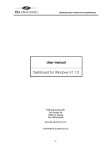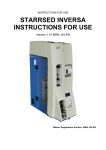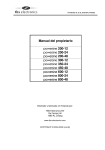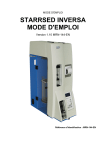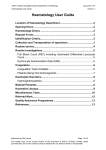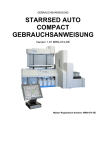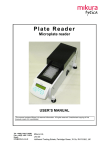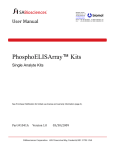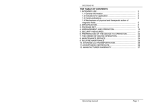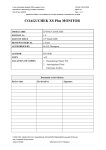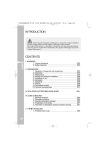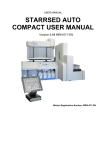Download An evaluation of the StaRRsed Compact
Transcript
August 2000 An evaluation of the StaRRsed Compact automated ESR analyser B J Garvey A Mahon J Parker-Williams I J Mackie C Gardiner S J Machin MDA Evaluation Centre UK NEQAS (H) Watford General Hospital Watford Department of Haematology University College London PO Box 14 London Contents Summary 3 Introduction 5 Technical assessment 15 Materials Comparability Comparison of timed methods Reproducibility Sample stability Comparison with ICSH standardised method Carry over Sampling error messages System messages Safety Efficiency assessment User acceptability Training & instruction manual 15 15 16 18 18 20 21 22 23 23 24 24 25 Costings 27 Acknowledgements 31 References 33 Appendix 35 Manufacturer' s comments Declaration of conformity with European directives Examples of report formats How to obtain MDA evaluation reports 35 36 37 39 Summary The StaRRsed Compact is a fully automated ESR analyser, which is based on the well tried functions of earlier models of StaRRsed and performs according to the Westergren method. As the name implies it is smaller than previous models and consists of a single bench top unit. The analyser can accept either EDTA blood or pre-citrated blood, there being a function available to switch off the citrate diluter on the instrument. However the main analysis mode is for whole blood ami coagulated with EDTA ie making use of the Full Blood Count sample, thus cutting down on the expense of purchasing special pre-citrated tubes for ESR samples. The analyser can also be attached in series to up to three other analysers for dealing with a very large workload and is able to interface with fully automated haematology systems. It requires 1 .2ml of blood to ensure that the analyser has a sufficient sample for testing. Two hundred and thirty EDTA samples from patients with a range of clinical conditions, some containing potential interfering substances were analysed on the StaRRsed Compact and the results were compared with the corresponding pre-citrated samples analysed on a Vesmatic in routine use. The StaRRsed gave a higher percentage of lower results than the Vesmatic, however, it must be pointed out that the technologies involved are completely different. In a separate study, 43 samples were selected at random and the results from the StaRRsed Compact compared with those obtained using the ICSH standardised method. The StaRRsed Compact performed well. Comparison between the 30 minute and one hour method of analysis showed excellent agreement. Reproducibility studies over a range of results from 2-110 mm fall gave a spread of values of only ± 1mm Carry-over was nil and washing and drying of the tubes was more than adequate. Sample stability studies showed that for up to 6 hrs samples are equally stable at room temperature or 4°C, but samples left overnight should be stored at 4°C for maximum stability. This applies to both EDTA and pre-diluted samples, however, refrigerated EDTA samples show slightly better stability than refrigerated citrated samples. Overall the StaRRsed Compact was found to be a reliable instrument, easy to use and maintain. It works most efficiently when large numbers of samples can be batched and the use of the 30minute program would be useful in a busy laboratory, especially if the analyser was part of an automated system. MDA Evaluation Report: StaRRsed Compact ESR analyser 4 Introduction The StaRRsed Compact ESR analyser is a fully automated analyser for the haematology laboratory made by Mechatronics Manufacturing BV in the Netherlands and marketed in the UK by: Vitech Scientific Ltd Huffwood Trading Estate Partridge Green West Sussex RH13 8AU Tel no: 01403 710479 Instrument description Figure 1: StaRRsed Compact ESR analyser MDA Evaluation Report: StaRRsed Compact ESR analyser 5 The StaRRsed Compact is a fully automated erythrocyte sedimentation rate (ESR) analyser, based on the well-tried functions of earlier models of StaRRsed ESR analysers. It produces a true Westergren result and conforms to the ICSH recommendations. The instrument consists of the following • a basic unit with a belt holding 84 precision bore glass Westergren pipettes. • a closed or open tube sampling unit, measuring unit, pipette wash station. • Bar-code reader, with positive sample identification. • serial/parallel interface • built in vacuum unit • complete accessories kit Space and service requirements The dimensions of the instrument are Width 750mm Height 800mm Depth 360mm Total weight 45kg Noise @ 1 metre <45dB Electrical requirements Mains voltage 100/240V. Power consumption 60VA in standby Interface 500VA maximum serial male 9 pin sub-D Parallel female 25 pin sub D The analyser is CE marked with respect to EEC directive 89/336/EEC and low voltage directive 73/23/EEC. MDA Evaluation Report: StaRRsed Compact ESR analyser 6 • Environmental requirements Operational temperature is not restricted as the instrument incorporates temperature correction software that corrects the ESR to a temperature of 18.3°C. (This feature may be switched off if not required). The noise level quoted by the manufacturer is less than 45db. Waste is collected in a 2.51 waste container; 0.lml of disinfectant is added to the waste line per sample. The waste can be disposed of down a sink with running water or plumbed directly into the the sink waste pipe. Microbiological filters protect the entire system. • Historical perspectives The erythrocyte sedimentation rate (ESR) is a commonly performed laboratory test with a long history. John Hunter, as far back as 1797, is credited with first noting that the speed of red cell sedimentation was increased in individuals suffering from non-specific inflammatory lesions and that the speed of sedimentation varied according to the severity of the infection. However, whilst others also noted the phenomenon, it was not until 1917 that interest in the test was renewed and the basic factors influencing the sedimentation rate gradually became understood. In 1920, Linzenmeir developed the first technique for the measurement of the ESR. In 1921 Westergren introduced a satisfactory method using a glass pipette some 200mm in length, 2.5mm internal diameter and graduated in mm. Wintrobe, in 1935, then developed his method whereby a special tube, 100mm in length and 3mm internal diameter, is graduated on one side from 0 to 10cm in 1mm divisions and on the other side from 10cm to 0 in 1mm divisions. Once the ESR had been measured using the 0 to 1 Ocm scale, the contents of the tube were centrifuged until packing of the red cells was complete and the packed cell volume of the blood was read using the 10cm to 0 scale. Although the test rapidly became a simple and popular test and has remained so ever since, there has always been a lack of consensus about the role of the ESR as a non-specific indicator of inflammation and tissue injury. Even though the usefulness of the test is decreasing as other methods of evaluating disease processes are developed, it does remain a useful marker of disease change, particularly in cases of rheumatoid arthritis, and is of great value in the rapid diagnosis of temporal arthritis and polymyalgia rheumatica. Nowadays the manual technique devised by Westergren is almost universally used. Blood that has been anticoagulated with K2EDTA or KsEDTA is diluted with 32.8 g/L tri-sodium citrate (109 mmol/L) in the proportion of one part citrate to four parts of blood. The pipette is filled with the suitably diluted blood, set perfectly upright and the numerical value in mm is obtained by measuring the distance from the surface to the upper limit of the red cell layer in the column of blood after exactly 60 minutes. MDA Evaluation Report: StaRRsed Compact ESR analyser 7 The International Council for Standards in Haematology (ICSH) in 1993 published a method for the control of ESR measurements using non-citrated EDTA blood. Based on the Westergren method, it is generally agreed that the method is too laborious for routine use and is not widely used, however it still remains as the ICSH Reference method and any new techniques should be evaluated against it. Current interest in ESR methodology has focused mainly on the development of automated closed systems that allow, in most cases, the sedimentation rate to be determined in the blood collection tube. Most of these automated methods do not support the use of the ICSH Reference Method and the technology employed by these instruments is often dissimilar. Some instruments report the Westergren ESR based on a 20 or 30 minute sedimentation extrapolated to one hour whilst other instruments allow the user to choose between a 1 hour or a 2 hour value. The StaRRsed Compact is the latest in a line of instruments, from Mechatronics, which produces a true Westergren result. The ESR is probably the second most frequently ordered haematology test but is undoubtedly the worst controlled. Despite the many factors known to influence the result of the ESR, a consistent commercial whole blood control material has only recently become available. Mechanism of red cell sedimentation The rate of sedimentation is not influenced by a single factor but by a number of interrelated factors. These combine and cause, to a greater or lesser extent, a difference in the specific gravity between red cells and plasma, and dictate, the degree to which the red cells form rouleaux. Rouleaux, being large clumps of cells, sediment more rapidly than single cells and formation increases with progressively higher concentrations of acute-phase proteins (fibrinogen in particular), but is retarded by albumin. The acute-phase proteins are a heterogeneous group, which include haptoglobins, ceruloplasmins, C-reactive protein and y-globulins. These proteins are synthesised in increased amounts in response to acute tissue damage, chronic inflammation, chronic infection and pregnancy. Principles of operation The system is based on the traditional one hour Westergren method, although there is an optional 30 minute method. The instrument contains a rotating belt, which holds 84 precision bore glass Westergren tubes. These are non-disposable and are cleaned automatically in situ with 8ml of a low foam detergent followed by a drying cycle. The instrument incorporates on-line citrate dilution allowing the ESR to be performed on routine EDTA samples. There is however a facility to analyse pre-citrated samples on the instrument if necessary. MDA Evaluation Report: StaRRsed Compact ESR analyser 8 The instrument will accept open or sealed tubes with a pierceable rubber septum and uses double needle aspiration. The Compact has a built in bar-code reader, however patient identification can also be entered manually using the keypad. Figure 2: The StaRRsed Compact keypad The StaRRsed Compact has a menu-controlled operating system. Each menu can be selected by pressing the menu key first (main menu) and scrolling using the arrow keys. Functions are displayed on the LCD screen and are easily accessible. In addition to showing functions the LCD screen also shows error messages and system information There are six menus available to users • • • • Menu 1: functions related to the sampling sequence Menu 2: functions relating to the fluid system Menu 3: functions related to timing and language selection Menu 4: functions related to the Bar-code reader, measure unit and pipette position. • Menu 5: functions related to RS232 communication and also access to the 30-minute function. MDA Evaluation Report: StaRRsed Compact ESR analyser 9 • Menu 6: functions relating to the handling of errors. There are three further menus, which can only be accessed by use of a password. • Menu 7: functions related to service and handling. • Menu 8: this is not in use at the present time • Menu 9: functions relating to solenoid valves and valve actuators • Menu 10: functions relating to peristaltic pumps and vacuum pumps Processing of samples On the main menu (no 1), select 1 -Run mode Insert a sample tube, after mixing gently at least eight times (ICSH recommendation), in the tube adapter with the bar-code label to the left and press the Fill key(this last step can be omitted if the auto-sample mode is selected). The bar-code details will be accepted by the analyser's software and the sampling sequence will take place. For sample tubes without details on a bar code, the patient identification is keyed in using the keypad; press the Fill key and the sampling sequence will take place. In the EDTA sample mode, a sensor detects the rate at which the blood is being drawn up and a diluter unit, situated at the right hand side of the analyser, adds citrate at the appropriate rate to produce a 1:4 dilution. If the EDTA mode is not selected then this dilution process is bypassed. Although the manufacturer states that the analyser uses only 1 ml of whole blood, it is advisable to have 1.2ml of blood in the sample tube to ensure adequate filling of the glass tubes. After each glass tube is filled with diluted blood, the fill line is back flushed with isotonic saline and air to avoid carry-over to the next sample. The analyser stores information about the sample, allowing its progress during testing to be investigated either by tube number or patient number. MDA Evaluation Report: StaRRsed Compact ESR analyser 10 After either 1 hour (or half an hour if shortened time selected) the belt will have migrated round to the measure position where a read head moves up the tube, producing a result every 0.25mm. This provides enough data to determine exactly where the plasma/red cell interface is. This is especially useful for samples, which give a hazy plasma/cell interface. The ESR result (corrected to one hour if the shortened time has been used) and the temperature are downloaded to a laboratory printer or a host computer, together with the patient identification number. Examples of the report formats can be seen in the Appendix. The analyser has a built in function which corrects the ESR measurement to 18.3°C, which falls within the ICSH recommended temperature range, giving consistency of results. This correction factor is shown below. MDA Evaluation Report: StaRRsed Compact ESR analyser 11 ESR measurement principle The automatic reading of the Westergren sedimentation pipettes is carried out by moving a sensor along the pipettes and measuring the absorption of infrared light. While the sensor is moving a reading is made every 0.25mm From these readings, values at a number of absorbance levels are determined as shown in figure 3. The red cell interface is taken to be the point where the maximum change in absorbence occurs. All absorbence figures are relative to the darkest and lightest reading (darkest = 100% and the lightest = 0% absorbence respectively). By definition the levels are:87.5% cells/plasma separation 75.0% haze detection 50.0% meniscus detection Figure 3: Absorbence readings Advantages of automation of ESR's The manufacturer states that advantages of automating the Westergren method of ESR determination using the StaRRsed Compact are as follows. • The pipettes are always filled to the correct level. • Using closed sample tubes reduces the possibility of contamination for the operator and the environment. • Standard glass Westergren pipettes are used in which the measurement can be corrected to a constant temperature. MDA Evaluation Report: StaRRsed Compact ESR analyser 12 Even small abnormalities can be detected over a longer period of time, irrespective of where and when the blood sample was taken. Every measurement is directly linked to an identified sample, so a manual worksheet is not necessary. Patient identification errors are reduced to a minimum by using the barcode reader. Data processing can be linked to a host or personal computer system. The used sedimentation pipettes are automatically washed and dried. In the EDTA mode the accuracy of the dilution of the EDTA blood with citrate is considerably better than manual dilution achieved by 'tipping off or using pre-filled evacuated blood tubes. The ESR's are read at exactly one hour, so there is consistency in results (however a 30-minute method is available on the instrument). Using a newly developed automatic sample feed called the Interliner, it is possible to incorporate the analyser into a fully automated system capable of accepting racks on a continuous basis and also to link up to four StaRRsed Compacts in parallel Reagents The manufacturer recommends that only the reagent containers, which are part of the instrument when delivered are used. Bulk reagents to replenish the containers on the instrument are supplied with plastic taps to avoid spillage and contamination. Users have the option of preparing their own reagents by the use of concentrates obtained from the manufacturer. The instrument incorporates five solutions and a waste container. Rinse solution : This is used for rinsing the Westergren pipettes. Approximately 8ml is used for each sample. Saline: Isotonic saline is used for cleaning the needle and fill nozzle assembly. Each sample uses approximately 3ml. MDA Evaluation Report: StaRRsed Compact ESR analyser 13 Diluent: 3.2% sodium citrate is used for diluting EDTA samples. Approximately 500 Cl is used for each sample. The prime cycle on the instrument uses 2.5ml. If the solution becomes turbid it must be discarded and the container cleaned with 10% sodium hypochlorite solution and rinsed in distilled water before refilling. De-ionised water: Deionised water is used for rinsing the fill-nozzle using approximately 500Dl. After 10 aspirations the outside of the metal fill-nozzle is washed automatically. Disinfectant: This is used to disinfect the waste system using approximately 500Dl after each pipette rinse. The manufacturer recommends the use of Virkon, however users who prefer to use sodium hypochlorite either in the form of 'household' bleach or laboratory grade sodium hypochlorite must ensure that concentrations of available chlorine quoted by the manufacturer in the user's manual are adhered to. Detergent, water, saline, disinfectant and waste bottles are all protected by level sensors which give an audible warning which requires manual intervention to cancel it. This occurs either when reagent levels become too low or the waste becomes full If the waste container becomes full, the alarm will sound and the analyser will stop all functions until the waste container has been emptied or replaced. In order to restart the analyser it is necessary to clear the fatal error (Menu 6, select 1, press enter). MDA Evaluation Report: StaRRsed Compact ESR analyser 14 Technical assessment Materials Controls ESR-Chex® whole blood Sed-rate control was used daily. The control was supplied by Alpha Labs and consisted of two levels. Level 1 had a value of 4-20mm fall in 1 hour and Level 2 had a value of 39-63mm fall in 1 hour. Both levels of controls were analysed daily with the first batch of samples and reproducibility over the length of the evaluation was excellent. Patient samples Patients' samples were collected into 4ml K3 EDTA vacutainer tubes supplied by BecktonDickinson. Analysis of samples was carried out within 2 hours of receipt in the laboratory, except in the case of ageing studies. EDTA samples were collected from the main haematology laboratory on those patients who had had an ESR requested by their doctor. • Comparability 230 EDTA samples were analysed on the StaRRsed Compact using the 1-hour method and the results were compared against the results from the method in routine use in the diagnostic haematology laboratory, which is the Vesmatic®. The Vesmatic® is operated in the 30-minute mode. Both instruments were situated in air-conditioned laboratories and the temperature in the evaluation laboratory was adjusted to that of the room in the haematology department. The results of the comparability can be seen in figure 4 and the differences between the StaRRsed and the mean of the results from the two instruments in figure 5. 'Ideally this 'difference plot' should show minimal scatter about the horizontal line. The values from the two instruments were compared using paired t-tests. The following results were obtained: Data from 230 samples were obtained. Mean difference between the StaRRsed Compact and the Vesmatic = -6.15 Standard deviation= 8.88 T critical two-tale value= 1.970 P (T< =t) two tail=<0.001 The results from the two systems were comparable although the Vesmatic read consistently higher than the StaRRsed Compact. MDA Evaluation Report: StaRRsed Compact ESR analyser 15 Technical assessment Figure 4: Comparison of StaRRsed Compact vs Vesmatic Figure 4: Difference plot StaRRsed Compact vs Vesmatic Comparison of timed methods The StaRRsed Compact offers the choice of two programs for ESR measurement: one hour, which is recommended by the manufacturer and 30 minutes. The results of the 30 minute program are corrected by the software to give the result expected if the one hour method had been used. For the purposes of the evaluation 84 samples were tested to give as wide a range of results as possible. The samples were first tested using the 30 minute method and then by the one hour method. MDA Evaluation Report: StaRRsed Compact ESR analyser 16 Technical assessment The one-hour method was taken as the standard as this is the method promoted by the manufacturer. The results of the comparison of the two methods can be seen in figure 5 with the difference plot shown in figure 6. In this case the difference is the 30-minute method minus the one-hour method. The values of the two methods were compared using paired t tests. Data from 84 samples Mean difference between the 30 min & Ihr method = -0.63 Standard deviation = 2.59 T critical two-tale value = 1.98 P (T< =t) two tail = 0.03 Figure 5: Comparison between 1hr and 30 minute methods. Technical assessment MDA Evaluation Report: StaRRsed Compact ESR analyser 17 Figure 6: Difference between 1hr and 30 minute methods Reproducibility For the purposes of the evaluation samples were selected to cover the following ranges: 2-17 mm fall in 1hr, 18-65 mm fall in 1hr and 65-110 mm fall in 1hr. Each sample was analysed three times in succession, using the 1hour program. Results are shown below in table 1. Table 1: Reproducibility ESR (mm fall in 1hr) Spread of results 2-17 mm 18-65mm 65-110mm ± 1mm ± 1mm ± 1mm The instrument gave reproducible results over the full range of ESR results. Sample stability Short term sample stability Short term sample stability was defined as stability over one working day. Ten patients chosen at random from the phlebotomy clinic were counselled and then samples were taken in duplicate into K.3 EDTA. The samples were identified by number only; no patients details were taken. The samples were analysed 15 minutes after taking to allow equilibration. One set of samples was stored at 4°C between analysis times, being allowed to warm up to room temperature before being tested. The other set of samples was kept at room temperature (18°C) for the duration of the test. Results can be seen in figure 7. MDA Evaluation Report: StaRRsed Compact ESR analyser 18 Technical assessment Figure 7: Short term sample stability Long term sample stability Long term sample stability was defined as stability over 24hrs. Twenty patients chosen at random from the phlebotomy clinic were counselled and then samples were taken in duplicate into K3 EDTA. The samples were identified by number only; no patients details were taken. One set of samples was diluted with 3% sodium citrate using calibrated positive displacement pipettes, to mimic samples which may be received in the laboratory already pre- diluted. The samples were analysed 15 minutes after taking to allow equilibration after dilution. The groups were then further divided into two and one group from each type of sample was stored in the refrigerator overnight while the other group was left at room temperature. Results: EDTA RT EDTA RT EDTA 4°C EDTA 4°C Initial Mean ESR = 28 24hrs Mean ESR = 14 Initial Mean ESR = 12 24hrs Mean ESR =13 Citrate RT Citrate RT Citrate 4°C Citrate 4°C MDA Evaluation Report: StaRRsed Compact ESR analyser Initial Mean ESR = 19 24hrs Mean ESR = 11 Initial Mean ESR = 9 24hrs Mean ESR = 6 19 Technical assessment From the results obtained it can be seen that the ESR results on samples received too late in the working day to be analysed are best stored overnight in the refrigerator. There is only a slight difference between results obtained from EDTA samples diluted by the instrument and pre-diluted citrate samples. Comparison with ICSH standardised method ICSH (1993) recommend that for validation of new methods of ESR estimation, the new methodology should be compared with the standardised method. The standardised method is performed on undiluted blood, the PC V of which has been corrected to 0.33 ± 0.03 using autologous plasma, in a Westergren tube under standardised conditions. The results are compared with those on the chart below, which has been issued to replace the use of the original formula. Figure 8. ICSH chart for verification of working method Forty-three out patients, who were having ESR samples taken as part of their blood test, were selected at random, and two extra EDTA samples were taken, and one sample was analysed on the StaRRsed Compact and then analysed on a Sysmex K1000 haematology analyser to ascertain the PCV. The PCVs were then adjusted using autologous plasma from the matching EDTA sample which had been centrifuged at 3500 rpm for 30 minutes. The plasma was measured using positive displacement pipettes for accuracy, and then the adjusted sample re-analysed to confirm that the adjusted PCV was within the recommended limits before testing by the ICSH standardised method. Comparison of the results from the StaRRsed Compact and the ICSH method can be seen in Table 2. (the StaRRsed Compact is the "working method" . The working MDA Evaluation Report: StaRRsed Compact ESR analyser 20 Technical assessment method limits are those quoted by the ICSH for specific values as measured by the standardised method in the range 15-105 mm. Table 2: StaRRsed Compact results compared with ICSH standardised method. Working StaRRsed ICSH Working ICSH method Compact Standardised method Standardised limits Method limits Method 18 20 23 24 26 31 17 30 39 37 25 58 49 53 56 66 67 71 97 75 105 102 4-15 5-17 6-19 7-19 8-21 10-25 4-15 10-24 14-31 13-30 7-20 26-49 20-40 23-44 25-47 32-58 33-59 36-63 59-94 40-68 67-104 64-100 4 5 6 8 8 10 13 14 16 17 20 27 31 34 46 51 59 63 63 68 83 100 20 30 20 24 27 33 18 40 37 23 39 47 63 45 72 67 69 72 75 86 101 5-17 10-24 5-17 7-19 8-21 11-26 4-15 15-32 13-30 6-19 14-31 19-38 30-54 18-37 37-64 33-59 35-61 37-64 40-68 49-80 63-99 StaRRsed Compact 5 6 6 8 8 12 14 15 17 19 20 28 31 37 49 59 60 63 68 80 99 All the StaRRsed Compact values fell within the corresponding working method limits, showing agreement with the ICSH standardised method. Carry over The method of Broughton et al was used to assess carry-over, by which a high level sample is analysed in triplicate, followed by a low-level sample. For this procedure the 30-minute program was used. A high level sample was aspirated in triplicate and the analyser allowed to complete the program. The carousel was then moved using menu 4 so that the same pipettes could be reused and a low-level sample was aspirated in triplicate. The analyser was allowed to complete the program. Results There was no evidence of carry-over. The cleaning and drying of the pipettes appears adequate. MDA Evaluation Report: StaRRsed Compact ESR analyser 21 Technical assessment Sampling error messages Generally the message 'clear' indicates a normal ESR sampling and reading, however , if errors are found during the measurement of samples, the StaRRsed Compact will give an audible alarm. The message is displayed on the LCD screen and sent to the printer. The following error messages may be reported: • No meniscus found • • • • No cells or plasma found Only one meniscus found Too many borders found ESR probably > 140mm • Poor meniscus found • Column height <nmm> No differential found between the top of the blood column and empty pipette. Differential between a filled and empty pipette too small. Only a separation between red cells and plasma found. More than three borders found, possibly air bubbles. Extreme high ESR value. Meniscus at the top of the column too small, fill & clean sequence needs to be performed Column height must be between 190 &210mm, <nmm> = the actual column height. The operator can accept the error messages by pressing the ESC key on the keypad. The alarm will be cancelled until another error is found. During the time of the evaluation the only error message generated was 'too many borders found' due to the presence of bubbles in the column of cells due to short sampling. There are two other messages which may appear which do not cause the alarm to be initialised. They appear in the report format. The evaluators found that an occasional sample gave a dilution out of range indication, in this case greater than ± 10%. However, when the sample was repeated the dilution was within range and both results were the same. • EDTA The number refers to the percentage of over (followed by a number) or under dilution compared to the ideal (100%). This can be set by the user from zero to ±20%. MDA Evaluation Report: StaRRsed Compact ESR analyser 22 Technical assessment • Hazy <10mm <25mm >25mm This is generated when the red cell interface is difficult to define. • System messages The StaRRsed Compact will present the operator with the following messages relating to the actual performance of the instrument. Waiting tube this is caused by a filled pipette being at the measuring position before the elapsed time is finished. No more samples can be aspirated until the pipette has been read and the results passed to the printer • This is generated in response to the 'switch printer on' message. Data will be stored in the buffer and can be printed afterwards. Printer failure Reagents level empty All reagent bottles have level detectors and the LCD screen will identify which reagent bottle is empty. • Waste full The waste container also has a level detector. If the waste container becomes full, the analyser will stop and will not continue working until the waste has been emptied and the fatal error cleared using menu 6. • Test messages During the start-up sequence all positioning sensors are tested. If incorrect a system error will be generated. These are explained in detail in the User's manual. Vacuum errors, dilution errors and fill time-out error messages are detailed in the User's manual Safety Microbiological safety Spores of Bacillus subtilis var. Niger and Uvitex, a liquid optical brightener, were diluted in ten EDTA samples according to the method of Kennedy et al (1998). MDA Evaluation Report: StaRRsed Compact ESR analyser 23 Technical assessment Before analysing the samples the room was blacked out and an ultra violet lamp shone on the analyser and su rrounding area to ensure no background contamination was present. The spiked samples were analysed by the StaRRsed Compact and the instrument was reexamined with the ultra violet lamp to identify any possible areas of contamination. A swab was taken from a sample to act as a positive control and one from an area away from the instrument as a negative control. Swabs were also taken from the outer needle sleeve, the sample inlet valve and the sample exit valve. The swabs were cultured in nutrient broth for 48hrs at 35°C. The positive control swab and the swab from the outer needle sleeve demonstrated bacterial growth. This is due to the fact that the outer needle sleeve punctures the sample lid and does not have a built in cleaning mechanism. Therefore it is necessary to include cleaning of the outer needle case with disinfectant as part of the routine daily maintenance. Electrical safety The StaRRsed Compact is CE marked with respect to the Machinery Directive (89/392/EEC) and a declaration of compliance is shown in the Appendix. Efficiency assessment The StaRRsed Compact has a throughput of approximately 80 samples per 50 minutes in the 30 minute program and 80 samples in 1hr 20 minutes in the 1hour program. This throughput is slightly lower if the samples have illegible bar codes and the patient identification has to be entered manually. Throughput is also dependent on the samples being well mixed prior to analysis and is obviously lower if samples have to be individually mixed prior to sampling. The most efficient way to operate the analyser is to group the samples into large batches and to operate the instrument in the 30-minute program. This would prevent slowing down the generation of reports for distribution to wards and medical staff, as an ESR often goes hand in hand with a full blood count and most haematology analysers are capable of producing over 100 results per hour. User acceptability The StaRRsed Compact is extremely easy to use and appears to be very reliable. It was not necessary to call in engineers during the time of the evaluation. However it takes 45 minutes to perform the shutdown sequence which the instrument carries out automatically. Weekly and monthly maintenance can take considerably longer, but is partly automated. ln a laboratory with only one instrument, it will need to be organised to complement the rest of the instrument maintenance in the laboratory. MDA Evaluation Report: StaRRsed Compact ESR analyser 24 Technical assessment The Compact does have the distinct advantage over other systems in that it makes use of the EDTA sample, so there are no extra costs for specially prepared tubes and the possibility of dilution error is reduced. Training and instruction manual Training was completed in less than one hour of the instrument being set up ready for use. As with all customers, the site was revisited two weeks after receiving the instrument to see if any problems had arisen. The User's manual is well presented, clearly formatted and easy to follow. MDA Evaluation Report: StaRRsed Compact ESR analyser 25 MDA Evaluation Report: StaRRsed Compact ESR analyser 26 Costings The manufacturer quotes the following prices for the instrument and the service charges. Cost of instrument: - PRICE LIST Automated ESR Analyser STARRSED COMPACT ESR Analyser, including 84 Precision Glass Tubes conforming to Westergren Dimensions, Automatic Sample Aspirator and Citrate dilution, Reading and Flushing/Washing Station, Sample I.D. Keyboard, Double RS232 Interface, Printer, Built in Vacuum Pump with separator ,Microbiological and activated charcoal filters provided, Automatic Bar Code Reader, Liquid level Sensors, Automatic Disinfecting of Waste lines and Waste bottle, Gives temperature corrected ESR results and reports abnormal results, Automatically dilutes blood with citrate in ratio 1 :4, eliminates need for dedicated citrated blood collection tubes for ESR test Accepts EDTA blood samples with bar coded labels. Competitive Lease Terms over 5,6,or 7 years available Prices exclusive of VAT & Delivery MDA Evaluation Report: StaRRsed Compact ESR analyser January 1999 27 Costings Cost of service :- STARRSED AUTOMATED ESR ANALYSER STARRSED COMPACT ESR Analyser complete with Citrate Addition VITACOVER £ Two preventative maintenance visits per year VITASURE £ Total Service Support All labour and parts (excluding consumables) in the event of a breakdown during normal use, also two preventative maintenance visits per year VTTACOVER- Full contract fee is payable on completion of the first scheduled visit of each contract year. VITASURE • Full contract fee is payable annually in advance. ALL PRICES ARE EXCLUSIVE OF V.A.T MDA Evaluation Report: StaRRsed Compact ESR analyser 28 Costings The manufacturer has provided the following information relating to the actual running costs of the instrument and the costs per test. Costings of Starrsed Compact ESR Analyser Costings have been calculated as per the ICSH recommendations. The Analyser has been fully amortised over 5 years, although based on the experience of other Starrsed Analysers the Compact should operate satisfactorily for up to 10 years. It is assumed that the manual ESR method takes 4 minutes per test (as per CAP and Welcan measurements) and that this can be halved when using Compact (less Phlebotomists time and less Laboratory time reading and writing down results). Labour costs have been calculated at £9 per hour. The cost of titrated blood collection tubes (for the manual method) has been assumed to be 15p each. The Supplier of Compact provides two alternative Service Contracts, Vitasure, a fully comprehensive contract providing full service cover including two preventative maintenance visits per annum and a cheaper, more basic contract, Vitacover which provides the two preventative maintenance visits only. Both types of Contract have been costed Tests Time per year per day (hours) Manual 10 30 50 100 300 170 520 860 1720 5200 Compact 90 260 430 860 2600 Consumables, cost per year, £ Manual 390 1170 1950 3900 11700 Compact 250 250 250 250 250 . Cost per test, £ Manual 0.75 0.75 0.75 0.75 0.75 Compact VS Compact VC 2.67 1.09 0.78 0.54 0.38 2.12 0.91 0.66 0.48 0.36 On this basis any Laboratory doing more than 50 ESRs a day should find it a worthwhile test to fully automate by means of a Starrsed Compact MDA Evaluation Report: StaRRsed Compact ESR analyser 29 Acknowledgements Acknowledgements The evaluators would like to acknowledge the assistance given by the phlebotomists in the Out Patients Department at Watford General Hospital in obtaining samples for the evaluation. We should also like to thank the biomedical scientists in the Haematology Department at Watford General Hospital for their assistance and patience at the interruptions caused in the search for samples for the comparability studies. We are also grateful to Alpha Laboratories who provided their ESR -Chex® free of charge. MDA Evaluation Report: StaRRsed Compact ESR analyser 30 References International Committee for Standardisation in Haematology (ICSH) 1973. Reference Method for the Erythrocyte Sedimentation Rate (ESR) Test on Human Blood. British Journal of Haematology; 24: 671. International Committee for Standardisation in Haematology (Expert panel on Blood Rheology) 1988. Guidelines on selection of laboratory tests for monitoring the acute phase response. J. Clin. Pathol; 41:1203 International Committee for Standardisation in Haematology (Expert panel on Blood Rheology) 1993. ICSH recommendations for measurement of erythrocyte sedimentation rate. J. Clin. Pathol; 46:1993 Rogers R 1994. The development of 30 minute ESR's on the 'StaRRsed' ESR Analyser; Medical Laboratory World, April 1994. Manley RW. (1957). The effect of room temperature on erythrocyte sedimentation rate and its correction. J Clin Pathol; 10. 1957:354. Garvey B, Mahon A, Parker-Williams J (1999). ESR-Chex® control material for erythrocyte sedimentation determination. MDA/99/28 MDA Evaluation Report: StaRRsed Compact ESR Analyser MDA Evaluation Report: StaRRsed Compact ESR analyser 33 31 APPENDIX Manufacturers Comments Huffwood Trading Estate, Partridge Green, West Sussex RH13 8AU 7W. (01403) 710479 FAX. (01403) 710382 18 August 2000 UK NEQAS (H) P.O.Box 14 Walford WD1 8FJ Dear Sir, Mechatronics, the Dutch Manufacturer, have asked us, as UK Distributor, to respond to the this evaluation. We would like to thank UK NEQAS(H), and especially Anne Mahon, for carrying out this evaluation. It is gratifying to note that these independent findings confirm our own view, and the views reached by existing users around the World, that the Starrsed Compact makes a useful contribution to the automation of the ESR test. We are sure this report will be useful to new users in the future. The Reproducibility data looks excellent although we would have liked to see rather more data points per sample. However, we understand the practical (and ethical) limitations of collecting large enough amounts of blood, particularly samples with a raised ESR. The fact that Vesmatic result were consistently higher than Compact results does not come as a surprise. Mechatronics have strived to ensure that all Starrsed ESR Analysers conform to the Westergren method in every detail and your own comparison between Compact and the ICSH Standardised Method confirms this to be the case. Yours faithfully Peter Hooper Managing Director MDA Evaluation Report: StaRRsed Compact ESR analyser 32 Apendix Declaration of conformity with European directives Mechatronics Instruments B.V. E.C.-DECLARATOIN OF CONFORMITY FOR MACHINERY (Directive 89/392/EEC, Annex II, sub A) Mechatronics Instruments B.V. De Factorij 12a 1689AL Zwaag The Netherlands Herewith declares that: Automatic E.S.R. analyser - StaRRsed Compact - Is in compliance with the Machinery Directive (89/392/EEC, as amended, 91/368/EEC, 93/44/EEC, 93/68/EEC) - Is in conformity with the provisions of the following other EEC directives: 73/23/EEC, 89/336/EEC, 93/68/EEC - The following harmonized standards have been applied: EN 292-1, EN 292-2, EN 294, EN 349, EN 60204-1 36 MDA Evaluation Report: StaRRsed Compact ESR analyser MDA Evaluation Report: StaRRsed Compact ESR analyser 33 Appendix Examples of report formats taken from User's Manual 9.1 60 minute mode: Depending on the StaRRsed Compact working mode, (60 or 30 minute) the printer report will be as follows. Normal 60 minute mode: 1. 2. 3. 4. Patient number. (Only in use if 30 minute mode is active) E.S.R. value normal 60 minute method. Sedimentation in millimetres corrected for 18°C. If the temperature correction is not activated then this column will remain empty. 5. Aspect (clear, hazy). 6. Manually entered code number. 7. Sedimentation pipette number (number on the pipette belt). 8. Sedimentation time in minutes. 9. Temperature (in degrees Centigrade). 10. Error message (if the StaRRsed Compact detects an error). 11. EDTA mode. ======= REPORT EXAMPLE ======= (not to scale) -StaRRsed(1) Patient (3) Sedi 972005001 972005002 972005003 972005004 83 14 23 67 Date 20/05/97 (4) Corr 75 13 21 61 (5) Aspect (6) (7) Manual aspect Tube time: (8) (9) (10) (11) Time Temp Error 17 18 19 20 Clear Hazy< 10mm Hazy< 25mm Hazy> 25mm 15.28 23 23 23 23 60 60 60 60 EDTA EDTA EDTA EDTA Sample result with a manual aspect, where the manual aspect is shown as a number "3". 972005005 4 4 Clear 3 21 60 23 EDTA Sample result with a dilution error, if a dilution is out of range more than +10% or -10% the rate will be printed as example EDTA 079. This means that the current sample has a dilution failure of -21%. 972005006 5 5 Clear 22 60 23 EDTA 079 If the text EDTA is not printed at the end of the result line the diluter was switched off and current sample was done in the "Citrate" mode. Sample result of a pipette possibly filled with air bubbles. 972005007 MDA Evaluation Report: StaRRsed Compact ESR analyser Too many borders found 34 Appendix 9.2 30 minute mode: 1. 2. 3. 4. Patient number. The actual half-hour result. E.S.R. value normal 60 minute method. Sedimentation in millimetres corrected for 18°C. If the temperature correction is not activated then this column will remain empty. 5. Aspect (clear, hazy). 6. Manually entered code number. 7. Sedimentation pipette number (number on the pipette belt). 8. Sedimentation time in minutes. 9. Temperature (in degrees Centigrade). 10. Error message (if the StaRRsed Compact detects an error). 11. EDTA mode. ======= REPORT EXAMPLE ======= (not to scale) - StaRRsed (1) Date 20/05/97 (2) (3) (4) Patient Hh Sedi 972005001 0 1 972005004 42 5 8 32 84 14 22 67 time: 15.28 (6) (7) Manual Corr Aspect aspect Tube 75 13 21 61 (5) Clear Hazy< 10mm Hazy< 25mm Hazy> 25mm (8) (9) Time 17 18 19 20 60 60 60 60 (10) Temp (11) Error EDTA EDTA EDTA EDTA 23 23 23 23 Sample result with a manual aspect, where the manual aspect is shown as a number "3". a 972005005 2 5 4 Clear 3 21 60 23 EDTA Sample result with a dilution error, if a dilution is out of range more than +10% or -10% the rate will be printed as example EDTA 079. This means that the current sample has a dilution failure of -21%. 972005006 2 5 5 Clear 22 60 23 EDTA 079 If the text EDTA is not printed at the end of the result line the diluter was switched off and current sample was done in the "Citrate" mode. Sample result of a pipette possibly filled with air bubbles. 972005007 U Too many borders found 9.3 Reporting messages: If errors are found during the measurement the StaRRsed will give an audible alarm. The message is displayed on the LCD screen and sent to the printer. MDA Evaluation Report: StaRRsed Compact ESR analyser 35 How to obtain MDA evaluation reports MDA evaluation reports are published by the Medical Devices Agency, an Executive Agency of the Department of Health. They are available free of charge to the UK National Health Service and are for sale to commercial organisations and other interested parties. A free catalogue can be obtained from the Orders Department or downloaded from the MDA's web site: www.medical-devices.gov.uk Ordering Send your order to the address given below, stating the reference number, title and quantity of each report required. Your reports will be despatched by second class post the following working day. If you are not a representative of the NHS, you will be invoiced separately. Non-NHS customers are reminded that it is not possible to offer refunds for reports ordered in error. Orders Department Room 1207 Medical Devices Agency Hannibal House Elephant & Castle LONDON SE16TQ Tel: 0207 7972 8181 Fax: 0207 7972 8105 E-mail: [email protected] Enquiries General enquires should be directed to the Orders Department, as above. Technical enquires should be addressed to Mrs Anne Mahon at the Evaluation Centre: Tel: 01923 217878 Fax: 01923 217879 Email: [email protected] MDA Evaluation Report: StaRRsed Compact ESR analyser 36




































